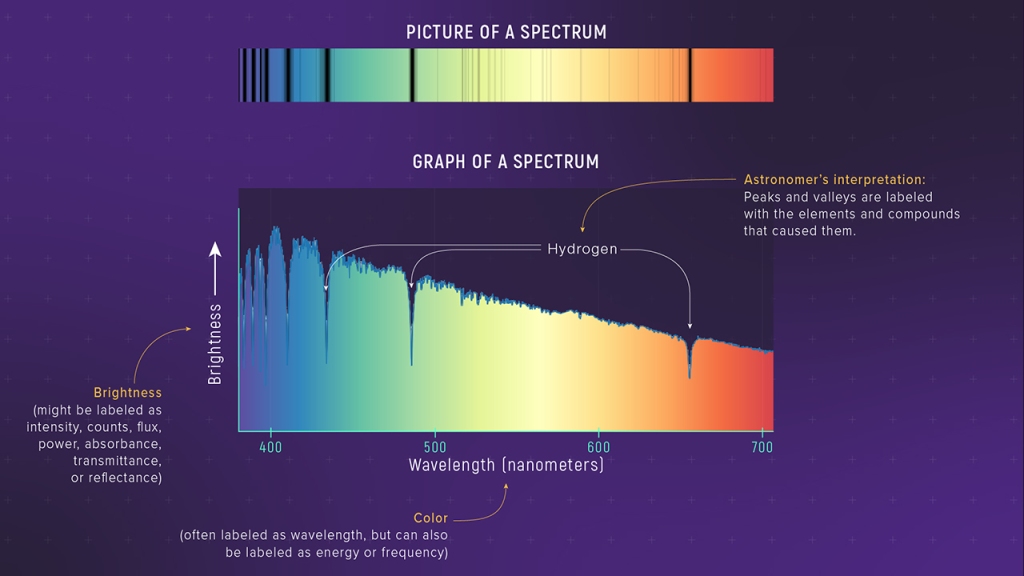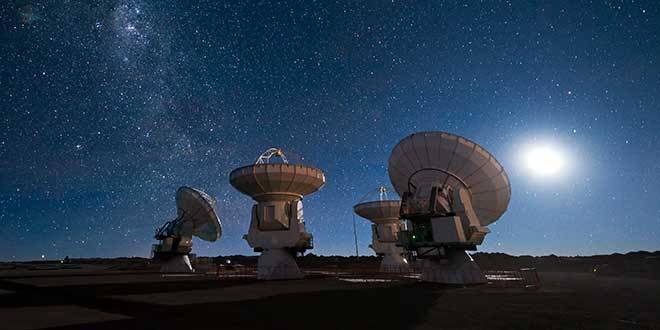
I’ll give you a hint: this is not an image of a quasar.
This image is from a first-season Star Trek: The Original Series episode, “The Galileo Seven”–the original footage, before it was remastered (and before astronomers had clear images of actual quasars).
According to the story, the crew of the USS Enterprise had standing orders to investigate any quasar they came across. A landing party spent the episode struggling to survive after they crashed on a primitive planetary body within a strange nebulosity that they called a “quasar.”
At times like these, Star Trek provides a fun glimpse into the past. TOS aired in the 1960s, just as very strange “quasi-stellar objects” were being discovered. Dubbed “quasars” for short, they were a new frontier of research and discovery.
The remastered footage uses an actual (if substantially edited) image of a quasar. But the “quasar” portrayed in the story…well…yeah, not even close.
So…what are quasars, really?
In a word, they’re…weird.
Below is the Hubble Deep Field, which I first showed you back in our discussion of galaxies.

This image is a long exposure shot of a tiny, apparently empty region of the night sky in the constellation Ursa Major. It reveals a universe teeming with galaxies.
The crazy thing about this image is that most of these dots of light–including all those faint, distant smudges that look barely bigger than specks–are whole galaxies. There are only a few foreground stars visible. I’ve circled the ones that my textbook confirms.
You can tell a star apart from a tiny speck of a distant galaxy by its diffraction spikes: those four bright spikes. These are a visual artifact created by the telescope’s optics.
When we see objects with diffraction spikes in deep field images, we can usually identify them as stars. Which is why the image below is really weird…

At first glance, this image appears to contain two stars: a bright white one and a fainter, redder one.
But the bright, white “star” in this image is a strong source of radio-wavelength energy. That’s not normal for a star (and I explain why here).
Since they look like stars but don’t behave like stars at all, objects like this were first dubbed “quasi-stellar objects,” a term that was soon shortened to quasars.
The first quasars to be discovered were the ones emitting radio energy, because radio astronomers essentially stumbled over them while studying other radio sources. But most quasars are, in fact, radio-silent.
That’s not all that’s weird about quasars. But first, let’s quickly review spectra.

Everything we know about most objects in the universe, we know from studying spectra like this.
Dips and spikes in the intensity of certain wavelengths of light indicate the presence of certain elements. Each element leaves a unique pattern–a bit like fingerprints.
Astronomers can use spectra to discover what an object is made of, whether it’s moving toward or away from Earth (and how fast), and–using the Hubble Law–how far away it is.
Alright, back to quasars.

This is the spectrum of quasar 3C 273. See those spikes in wavelength intensity?
That’s not where they’re supposed to be.
At first, astronomers studying quasars weren’t at all sure what they were looking at. These spikes didn’t correspond to any known element. But astronomers realized that they could be looking at a redshift.
What’s redshift, again?

In general, redshifts are due to the Doppler Effect–which is how astronomers know if an object is moving toward us or away from us.
Essentially, an object’s spectral lines–that is, the fingerprints that elements leave on their spectra–will appear to shift toward the blue end if the object is moving toward us, and toward the red end if the object is moving away from us.
Notice below that the distances between spectral lines themselves stay the same. This is the “fingerprint” pattern. But the entire pattern gets shifted in one direction or the other.

In other words, quasars’ spectral lines might not appear where we expect them to because they are redshifted or blueshifted.
By measuring the redshifts or blueshifts mathematically, astronomers can also find the actual speed at which the object is moving toward or away from us.
In 1963, astronomer Maarten Schmidt at Hale Observatories tried calculating redshifts for a particular series of spectral lines: the hydrogen Balmer series. (I explained the Balmer series here, but the long story short is that these spectral lines are produced when light interacts with electrons in an atom’s second energy level.)
Schmidt found something extraordinary.

For quasar 3C 273, the Balmer lines clicked into place at a redshift of 15.8%.
Anyone know what that means?
Remember that redshifts indicate an object’s velocity of recession: that is, the speed at which it’s moving away from us. A redshift of 15.8% means that the object is receding at 15.8% of the speed of light.
The Hubble Law, which relates redshift to distance, tells us that this quasar must be ridiculously far away.

As a matter of fact, many quasars have been found to have redshifts of more than 1.0, which indicates a recessional velocity greater than the speed of light. And that is beyond whacky.
The speed of light in a vacuum is known as the “universal speed limit” for a reason: nothing can move faster. That’s the laws of physics. So what the heck is going on with these quasars?
As it turns out, quasars’ redshifts are not produced by the Doppler Effect. They’re actually produced by the expansion of the universe. But that’s spoilers for our cosmology unit coming up!
Anyway. Let’s get back to quasar 3C 273.

You know how we just said that quasars are ridiculously far away?
So…how come they’re so bright, they look like stars? 3C 273 here appears brighter than a foreground star within our own galaxy!
Using a quasar’s apparent magnitude (how bright it appears from Earth) and its distance (calculated using the Hubble Law), astronomers can calculate their luminosity (their total radiation output). And we discover that they are insanely bright.
I’m talking 10 to 1000 times the luminosity of our entire galaxy.
But here’s what’s even crazier…

We’ve detected fluctuations in quasars’ brightness over intervals of just a few hours. Because an object can’t change brightness any faster than the time it takes light to cross its diameter, we know that quasars can’t be any more than a few light-hours in diameter.
People…that’s smaller than our whole solar system.
Apparently, quasars are not just insanely bright; they’re also insanely small. But what the heck could be smaller than our solar system and yet produce 10 to 1000 times more energy than our entire galaxy?
As with most advances in astronomy, the answers have come with the advent of newer and larger telescopes.

Astronomers have observed faint, hazy features around quasars with spectra we’d expect from normal galaxies. And, thanks to radio telescopes, we’ve also discovered quasars with jets and radio lobes–hallmark features of active galaxies.
What are quasars, then?
They are a type of active galactic nucleus (AGN), like the nuclei of Seyfert galaxies and galaxies with radio lobes. Like other AGN, their titanic energy production is thanks to a central supermassive black hole. But quasars are by far the most extreme type of AGN.
And Captain Kirk and crew definitely couldn’t have stumbled upon one in our own Milky Way, where Star Trek takes place–let alone landed a shuttlecraft on a planet within one! But I suppose we can forgive them; after all, the episode had a good story. 😉
Next up, we’ll take a deeper dive into the mechanics of AGN and supermassive black holes!